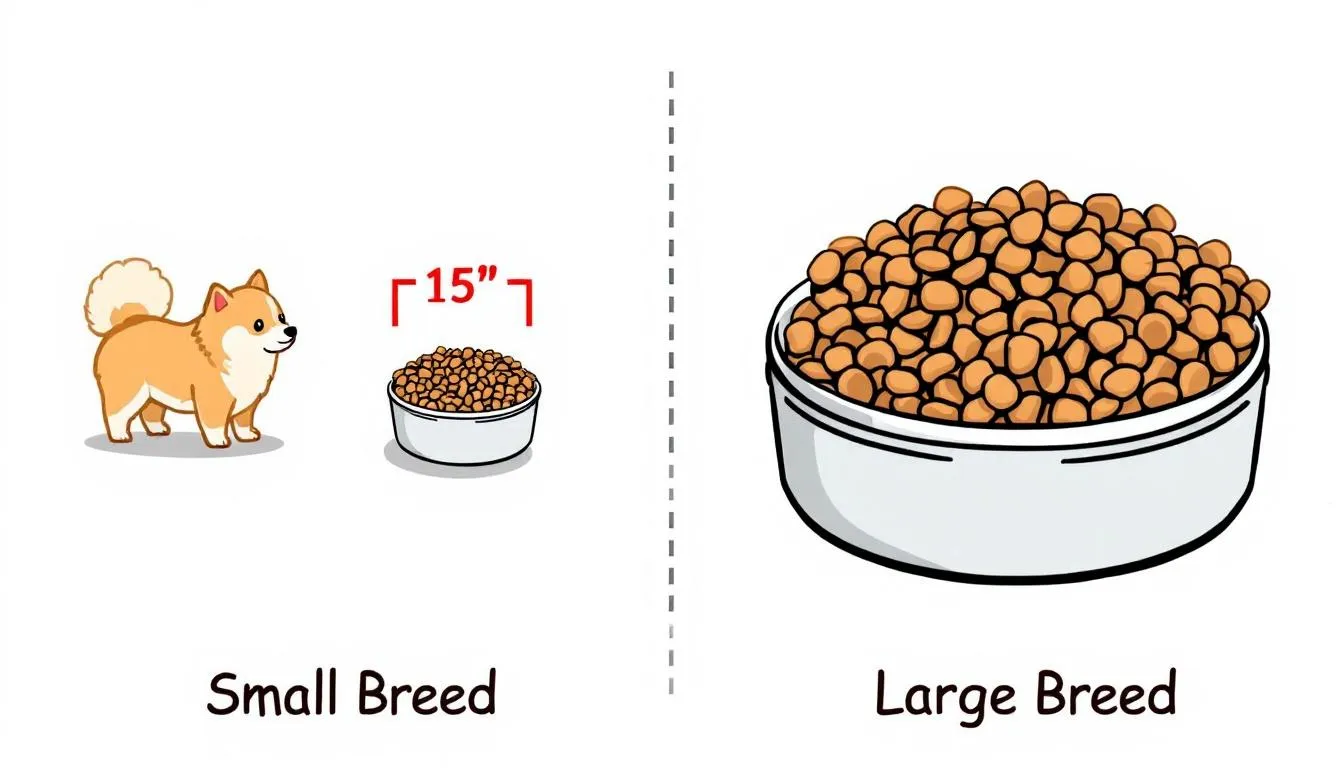

Key Takeaways
Small dogs (under 20 pounds) require more calories per pound than large dogs due to their faster metabolism
- Small dogs (under 20 pounds) require more calories per pound than large dogs due to their faster metabolism
- Specially formulated small breed dog foods with smaller kibble sizes prevent choking and support easier chewing
- Feed small breed puppies 4-6 times daily with calorie-dense food to prevent hypoglycemia
- Portion control is critical - small dogs are prone to obesity which can reduce their lifespan by up to 2 years
- Complete and balanced commercial diets meeting AAFCO standards provide all essential nutrients for small breeds
Specially formulated small breed dog foods with smaller kibble sizes prevent choking and support easier chewing
Feed small breed puppies 4-6 times daily with calorie-dense food to prevent hypoglycemia
Portion control is critical - small dogs are prone to obesity which can reduce their lifespan by up to 2 years
Complete and balanced commercial diets meeting AAFCO standards provide all essential nutrients for small breeds
Your small dog’s big personality deserves nutrition that matches their unique needs. Unlike their larger counterparts, small breed dogs face distinct feeding challenges that require thoughtful attention. From preventing dangerous blood sugar drops in puppies to managing weight in adults who can gain pounds from just a few extra treats, feeding small dogs correctly makes the difference between thriving and merely surviving.
This small dog diet guide covers everything you need to know about feeding your small breed companion. We’ll explore why size matters in dog nutrition, break down essential nutrients, and provide practical feeding schedules that work with real life. Whether you’re welcoming a new small breed puppy or fine-tuning your adult dog’s diet, these evidence-based recommendations will help you make informed decisions about your dog’s food.
Understanding Small Dog Nutritional Needs
Small breed dogs have fundamentally different nutritional requirements compared to large dogs, stemming from their unique physiology and metabolism. Dogs weighing under 20 pounds burn energy at a much faster rate than their larger counterparts, requiring significantly more calories per pound of body weight to maintain their health and energy levels. A small dog's diet should be carefully balanced with the right amounts of protein, fiber, carbohydrates, and fats to support a healthy weight and overall well-being.
Because of their rapid metabolism, small dogs also need more frequent meals and precise portion sizes. It is important to monitor your small dog's daily intake of both food and water to ensure proper hydration and nutrition.
When choosing food for your small dog, look for high-quality dog's food that meets the specific needs of small breeds to help them maintain optimal health.
Why Small Dogs Have Unique Dietary Requirements Compared to Large Breeds
The metabolic differences between small and large dogs are striking. A 10-pound adult dog typically needs 35-40 calories per pound daily, while a 70-pound dog requires only 20-25 calories per pound. This higher metabolic rate means small dogs process food faster and need more frequent meals to maintain steady blood sugar levels. When considering how many calories small dog breeds require per day, it's important to note that the exact amount can vary by breed, so always consult your veterinarian to determine the right caloric intake for your specific dog breed.
Small breed dogs also have proportionally smaller stomachs, which limits how much food they can consume in a single meal. This smaller stomach capacity necessitates frequent, smaller meals rather than one or two large feeding sessions. Their faster energy burn requires calorie-dense nutrition packed into manageable portion sizes.
Higher Metabolic Rate Requiring More Calories Per Pound of Body Weight
Most dogs in the small breed category maintain metabolic rates that can be nearly twice as high as large breed dogs. This increased metabolism supports their active lifestyles and helps maintain their body temperature, but it also means they’re more susceptible to energy depletion between meals. A dog's unique metabolism requires careful attention to their dietary needs to ensure a balanced dog's diet that supports optimal health.
Small adult dogs need nutrient-dense foods that deliver maximum nutrition in minimal volume. The higher calorie requirements per pound make portion accuracy extremely important - even small measurement errors can lead to significant overfeeding or underfeeding.
Weaker Jaw Strength Requiring Appropriately Sized Kibble
Small breed dog food features smaller kibble specifically designed for weaker jaw strength and smaller mouths. Large kibble pieces can pose choking hazards and make eating uncomfortable or difficult for small dogs. The appropriately sized kibble also encourages proper chewing, which supports dental health and improves digestion.


Essential Nutrients for Small Dogs
Small breed dogs require the same spectrum of nutrients as larger dogs but in different proportions and concentrations. Understanding these nutritional needs helps you evaluate dog food options and ensure your small dog receives complete and balanced nutrition. A dog's diet should include essential nutrients such as protein, carbohydrates, fats, and fiber to support overall health, with dietary fats and fatty acids playing a key role in maintaining healthy skin and a shiny coat.
Protein Requirements: Minimum 22.5% for Puppies, 18% for Adults
Protein forms the foundation of healthy muscle development and maintenance in small dogs. Small breed puppies need at least 22.5% protein content in their food to support rapid growth, while adult dogs require a minimum of 18% protein for maintenance.
High quality proteins from animal sources provide the most bioavailable amino acids for small dogs. The protein in small breed dog food should be easily digestible to maximize absorption in their smaller digestive systems.
Fat Content: 8.5% Minimum for Growth, 5.5% for Maintenance
Fat serves as the most concentrated energy source in dog food, making it particularly important for small breed dogs with their high energy requirements. Growing small breed puppies need at least 8.5% fat content, while adult dogs require a minimum of 5.5% for basic maintenance.
Many small breed formulas contain higher fat levels - sometimes 15-25% - to provide adequate calorie density. However, this increased fat content requires careful portion control to prevent unwanted weight gain in less active dogs.
Vitamins and Minerals for Immune Support and Bone Health
Small dogs need the complete spectrum of vitamins and minerals, with particular attention to calcium and phosphorus ratios for proper bone development. Antioxidants like vitamin E support immune system function and may contribute to the longer lifespans typical of small breeds.
The concentration of these micronutrients in small breed dog food accounts for the higher metabolic rate and smaller portion sizes. Vitamin supplements are rarely necessary when feeding a complete and balanced food that meets American Feed Control Officials standards.


Feeding Guidelines by Life Stage
Small dogs progress through distinct life stages, each with specific nutritional requirements and feeding schedules. Understanding these differences ensures your dog receives appropriate nutrition throughout their lifetime, including special dietary considerations for older dogs as they enter their senior years.
Small Breed Puppies (0-12 months)
Small breed puppies face unique nutritional challenges due to their rapid growth rate and susceptibility to low blood sugar. These tiny dogs can develop hypoglycemia quickly when meals are delayed or insufficient. Warning signs of low blood sugar in small breed puppies include muscle tremors, lethargy, weakness, and even seizures.
Small breed puppy feeding schedules should include 4-6 small meals throughout the day. This frequent feeding prevents dangerous blood sugar drops that can cause weakness, lethargy, or even seizures. Puppies under 12 weeks are particularly vulnerable and may need feeding every 2-3 hours during daytime.
Consistency in feeding times helps establish routine and allows you to monitor your puppy’s appetite and energy levels. Keep puppy food easily accessible and never skip scheduled meals, especially for toy breeds under 5 pounds.
Small breed puppy food contains higher calorie density and nutrients specifically formulated for rapid growth. The smaller kibble size prevents choking and makes eating easier for developing jaws. Look for food labeled specifically for small breed puppies rather than general puppy formulas.
High-calorie, nutrient-dense foods support the intense growth period when small breed puppies typically reach adult size by 9-12 months. The concentrated nutrition helps meet their energy needs without requiring large volume consumption.
Adult Small Dogs (1-8 years)
Adult small breed dogs require consistent nutrition and feeding schedules to maintain optimal health and body weight. This life stage focuses on maintenance rather than growth, requiring careful attention to portion control.
Most adult small dogs thrive on 2-3 meals per day, with some individuals doing better with three smaller meals rather than two larger ones. Measure portions carefully using standard measuring cups rather than estimating, as even small overfeeding can lead to rapid weight gain.
Maintain consistent feeding times to support digestive health and help with house training routines. Monitor your dog’s body condition regularly by feeling for rib coverage and observing waist definition from above.
Adult small breed dog food provides balanced nutrition without the excess calories needed for growth. These formulas typically contain 22-28% protein and 12-20% fat, with smaller kibble sizes that accommodate adult small dog jaw strength and dental health needs.
Quality adult formulations support the active lifestyle of healthy small dogs while providing nutrients that may help prevent age-related health issues. Look for foods that list specific meat sources as the first ingredient.
Senior Small Dogs (8+ years)
Senior small dogs may benefit from dietary adjustments to support their changing nutritional needs and potential health concerns. Many small breeds live 12-16 years, making proper senior nutrition crucial for quality of life.
Senior pet foods often contain increased antioxidants, omega fatty acids, and nutrients that support joint health and cognitive function. These formulations may also have adjusted protein and fat levels to accommodate decreased activity levels and metabolic changes.
Some senior dogs develop health conditions requiring prescription diets formulated by a board certified veterinary nutritionist. Regular veterinary monitoring helps identify when dietary changes might benefit your aging dog.
Choosing the Right Dog Food
Selecting appropriate food for your small breed dog involves evaluating multiple factors beyond marketing claims. Understanding food labels and quality indicators helps you make informed decisions about your dog’s diet. It is especially important to choose food specifically formulated for small dog breeds, as these breeds have unique nutritional needs and require diets tailored to their size, metabolism, and health vulnerabilities.
Look for “Complete and Balanced” AAFCO Statement on Labels
The American Feed Control Officials sets nutritional standards for pet foods sold in the United States. Foods meeting these standards display an AAFCO statement confirming they provide complete and balanced nutrition for specific life stages.
This statement indicates the food has either undergone feeding trials or meets established nutrient profiles. For small breed dogs, look for foods specifically labeled for “small breed” or “toy breed” life stages rather than general formulations.
Select Small Breed Specific Formulations
Small breed dog food addresses the unique nutritional needs we’ve discussed - higher calorie density, smaller kibble size, and nutrient profiles tailored to faster metabolisms. These specially formulated diets often cost more than general dog foods but provide better value through improved nutritional efficiency.
Major dog food brands like Royal Canin, Hill’s Science Diet, and Purina Pro Plan offer small breed formulations developed with input from veterinary nutritionists. These companies invest heavily in research and quality control systems.
Consider Dry vs. Wet Food Benefits and Drawbacks
Dry food offers convenience, dental benefits through chewing action, and longer storage life once opened. The smaller kibble in small breed dry formulations encourages proper chewing and may help reduce tartar buildup.
Wet food provides higher moisture content and may be more palatable for picky eaters or senior dogs with dental issues. Some small dogs benefit from a combination of both dry and wet foods to balance convenience with palatability and hydration.


Portion Control and Weight Management
Proper portion control becomes critical for small dogs because their smaller size makes even minor overfeeding significant. A few extra treats or slightly generous portions can quickly lead to obesity and related health problems. Unexplained weight loss in small dogs, on the other hand, may be a sign of intestinal parasites and should prompt a veterinary checkup.
Use Feeding Guidelines on Packaging as Starting Point
Dog food packaging provides feeding guidelines based on adult size and activity level. These recommendations serve as starting points, but individual dogs may need adjustments based on their metabolism, health status, and daily activity levels.
For small breed dogs, measure portions using standard measuring cups rather than estimating. A difference of even 1/4 cup can represent a significant percentage increase in daily caloric intake for a small dog.
Monitor Body Condition Score Regularly
Regularly assess your dog’s body condition by feeling for rib coverage and observing their waist when viewed from above. You should be able to feel the ribs easily without seeing them prominently, and there should be a visible waist tuck when viewed from the side.
Weight changes happen quickly in small dogs, so weekly weigh-ins during diet adjustments help track progress. Many veterinary clinics allow owners to use their scales for regular monitoring between appointments.
Prevent Obesity to Avoid Diabetes, Heart Disease, and Joint Problems
Obesity in small dogs significantly increases risks for diabetes, heart disease, and joint problems that can dramatically impact quality of life. It can also lead to high blood pressure, further complicating your dog's health. Obese dogs typically have lifespans reduced by up to 2 years compared to dogs maintained at healthy weights.
Small breed dogs are particularly susceptible to weight gain because treats and table scraps represent a larger percentage of their daily caloric needs. A single small dog biscuit might contain 5-10% of a toy breed’s daily calorie requirement.
Common Feeding Mistakes to Avoid
Understanding common feeding errors helps prevent nutritional problems and health issues in small breed dogs. Many well-intentioned pet parents make mistakes that can have serious consequences for their small dogs.
Overfeeding Leading to Obesity and Health Complications
The most common mistake is overfeeding, often through generous portions combined with frequent treats. Small dogs can become overweight quickly because their caloric needs are relatively small, making portion accuracy extremely important.
Free-feeding, where food remains available all day, often leads to overeating and makes it difficult to monitor appetite changes that might indicate health problems. Scheduled meals provide better portion control and health monitoring opportunities.
Using Large Breed Dog Food with Oversized Kibble
Large breed dog food contains kibble too large for small dogs to chew properly, potentially causing choking hazards or encouraging them to swallow pieces whole. The nutritional profile also doesn’t match the higher energy density needs of small breed dogs.
Some pet parents choose large breed food thinking it’s more economical, but small dogs eat such small quantities that the cost difference between large breed and small breed formulations is minimal per feeding.
Feeding Table Scraps or Inappropriate Human Foods
Table scraps can quickly unbalance a carefully planned diet and contribute excess calories. Many human foods are also toxic to dogs, including chocolate, grapes, onions, and artificial sweeteners like xylitol.
Even safe human foods like plain chicken can cause digestive upset when added to complete and balanced commercial diets. The concentrated nutrition in small breed dog food doesn’t accommodate additional calories from human food without risking nutritional imbalance.
Special Dietary Considerations
Some small breed dogs require specialized diets due to food allergies, health conditions, or specific nutritional needs. Different dog breeds may have unique dietary requirements, so choosing the right dog's food is essential for managing these needs. Understanding these special circumstances helps you work with your veterinarian to address individual requirements.
Food Allergies and Elimination Diets
Food allergies in small dogs often manifest as skin problems, digestive issues, or chronic ear infections. True food allergies are less common than food intolerances, but both require dietary management for symptom relief.
Elimination diets using novel proteins or hydrolyzed protein formulas help identify problematic ingredients. These specialized diets should be conducted under veterinary supervision to ensure nutritional adequacy while identifying triggers.
Prescription Diets for Health Conditions
Small breed dogs may develop health conditions requiring therapeutic diets formulated for specific medical needs. Common prescription diets address kidney disease, heart conditions, digestive sensitivities, and weight management.
These therapeutic foods are formulated by veterinary nutritionists and available only through veterinary clinics. They provide targeted nutrition that supports medical treatment while maintaining complete and balanced nutrition.
Homemade Diets and Nutritional Consultation Requirements
Some pet parents prefer preparing homemade diets for their small dogs, but this approach requires careful planning to ensure nutritional completeness. Small dogs are particularly vulnerable to nutritional imbalances due to their higher metabolic rates and smaller margin for error.
Homemade diets should be formulated with guidance from a board certified veterinary nutritionist to prevent deficiencies or excesses that could harm your dog’s health. The American College of Veterinary Nutrition provides resources for finding qualified nutritional consultants.
Small dogs require precise nutrition that supports their unique physiology and active lifestyles. By understanding their specific needs for calorie-dense, appropriately sized food served in carefully measured portions, you can help your small breed companion live a long, healthy life. Remember that consistency in feeding schedules, attention to body condition, and regular veterinary monitoring form the foundation of successful small dog nutrition.
The investment in quality small breed dog food and careful portion management pays dividends in your dog’s health, energy, and longevity. When questions arise about your dog’s diet, consult with your veterinarian or a board certified veterinary nutritionist for personalized guidance that considers your individual dog’s needs and circumstances.
FAQ
How often should I feed my small dog?
Puppies under 6 months should eat 4-6 times daily, adult small dogs should eat 2-3 times daily, and senior dogs may benefit from smaller, more frequent meals depending on their health condition. The frequent feeding schedule for puppies prevents dangerous blood sugar drops, while adult feeding schedules support proper digestion and weight management.
Can small dogs eat the same food as large dogs?
While nutritionally similar, small dogs benefit from foods specifically formulated for their size with smaller kibble, higher calorie density, and nutrients tailored to their faster metabolism and unique health risks. Large breed kibble can pose choking hazards and doesn’t provide the concentrated nutrition small dogs need in their smaller portions.
What are signs my small dog is eating too much?
Weight gain, difficulty feeling ribs, loss of visible waist, decreased activity, and breathing difficulties are common signs of overfeeding that require immediate portion adjustment and veterinary consultation. Small dogs can gain weight rapidly, so monitoring body condition weekly helps catch overfeeding early.
Should I free-feed my small dog or use scheduled meals?
Scheduled meals are recommended for small dogs as they help prevent hypoglycemia, allow better portion control, aid in house training, and make it easier to monitor appetite and health changes. Free-feeding makes it difficult to track food intake and can lead to overeating in many small dogs.
When should I switch from puppy to adult food for my small breed dog?
Most small breed dogs should transition to adult food around 10-12 months of age, but consult your veterinarian as some toy breeds may need to switch earlier due to their rapid maturation rate. The transition should happen gradually over 5-7 days to prevent digestive upset.
FAQ
How often should I feed my small dog?
Puppies under 6 months should eat 4-6 times daily, adult small dogs should eat 2-3 times daily, and senior dogs may benefit from smaller, more frequent meals depending on their health condition. The frequent feeding schedule for puppies prevents dangerous blood sugar drops, while adult feeding schedules support proper digestion and weight management.
Can small dogs eat the same food as large dogs?
While nutritionally similar, small dogs benefit from foods specifically formulated for their size with smaller kibble, higher calorie density, and nutrients tailored to their faster metabolism and unique health risks. Large breed kibble can pose choking hazards and doesn’t provide the concentrated nutrition small dogs need in their smaller portions.
What are signs my small dog is eating too much?
Weight gain, difficulty feeling ribs, loss of visible waist, decreased activity, and breathing difficulties are common signs of overfeeding that require immediate portion adjustment and veterinary consultation. Small dogs can gain weight rapidly, so monitoring body condition weekly helps catch overfeeding early.
Should I free-feed my small dog or use scheduled meals?
Scheduled meals are recommended for small dogs as they help prevent hypoglycemia, allow better portion control, aid in house training, and make it easier to monitor appetite and health changes. Free-feeding makes it difficult to track food intake and can lead to overeating in many small dogs.
When should I switch from puppy to adult food for my small breed dog?
Most small breed dogs should transition to adult food around 10-12 months of age, but consult your veterinarian as some toy breeds may need to switch earlier due to their rapid maturation rate. The transition should happen gradually over 5-7 days to prevent digestive upset.






